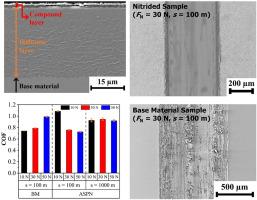主动屏等离子体氮化FeAl40合金对WC-6Co的微观组织及无润滑滑动磨损行为
IF 6.1
1区 工程技术
Q1 ENGINEERING, MECHANICAL
引用次数: 0
摘要
研究了FeAl40合金在575°C的氮气-氢混合物(30vol %的氮气)中活性屏蔽等离子体氮化(ASPN) 4小时后形成的氮层微观结构及其对严重磨损条件下摩擦学行为的影响。在各种正常载荷FN(10牛、30牛、50牛)和滑动距离s(100米、1000米)的环境条件下,使用无润滑的线性往复滑动球-盘面磨损试验对WC-6Co球-counterbodies(6毫米)进行摩擦性能评估。在ASPN过程中形成结构复杂的氮化物层,由复合双分子层和扩散层组成。值得注意的是,复合双层的微观结构由以氮化铁为主的外亚层和以氮化铝为主的内亚层组成,这与FeAl40合金气体渗氮和传统等离子体渗氮形成的“白色”复合层有明显区别。扩散层含有非常高的氮含量,高达38 at。%的氮在层内形成Fe和Al的氮化相,使表面硬度提高到1550 HV0.05。氮化层的存在改变了FeAl40合金的磨损机理,以双体磨粒磨损为主。结果,与基材相比,氮化样品表现出优异的耐磨性,比磨损系数(k)随着FN的增加而降低。本文章由计算机程序翻译,如有差异,请以英文原文为准。

Microstructure and unlubricated sliding wear behavior of active screen plasma nitrided FeAl40 alloy against WC-6Co under ambient conditions
This study examines the microstructure of the nitride layer formed on FeAl40 alloy during active screen plasma nitriding (ASPN) at 575 °C for 4 h in a nitrogen-hydrogen mixture (30 vol% nitrogen) and its effect on the tribological behavior under severe wear conditions. The resulting tribological properties are evaluated using unlubricated linear-reciprocating sliding ball-on-disc wear tests against WC-6Co ball-counterbodies (ϕ6 mm) applying various normal loads FN (10 N, 30 N, 50 N) and sliding distances s (100 m, 1000 m) under ambient conditions. During ASPN a complex-structured nitride layer forms, consisting of a compound bilayer and a diffusion layer. Notably, the microstructure of the compound bilayer consists of an outer sublayer with mainly iron nitrides and an inner sublayer with additional aluminum nitride, which differs significantly from the “white” compound layer formed by gas nitriding or conventional plasma nitriding, respectively, on FeAl40 alloy. The diffusion layer contains a very high nitrogen content up to 38 at.% nitrogen forming nitride phases of Fe and Al within the layer, resulting in an increase in surface hardness up to 1550 HV0.05. The presence of the nitride layer causes a change in the wear mechanism of the FeAl40 alloy, where the two-body abrasive wear is dominant. As a result, the nitrided samples exhibit excellent wear resistance with a reduction of the specific wear coefficient (k) with increasing FN, in contrast to the base material.
求助全文
通过发布文献求助,成功后即可免费获取论文全文。
去求助
来源期刊

Wear
工程技术-材料科学:综合
CiteScore
8.80
自引率
8.00%
发文量
280
审稿时长
47 days
期刊介绍:
Wear journal is dedicated to the advancement of basic and applied knowledge concerning the nature of wear of materials. Broadly, topics of interest range from development of fundamental understanding of the mechanisms of wear to innovative solutions to practical engineering problems. Authors of experimental studies are expected to comment on the repeatability of the data, and whenever possible, conduct multiple measurements under similar testing conditions. Further, Wear embraces the highest standards of professional ethics, and the detection of matching content, either in written or graphical form, from other publications by the current authors or by others, may result in rejection.
 求助内容:
求助内容: 应助结果提醒方式:
应助结果提醒方式:


